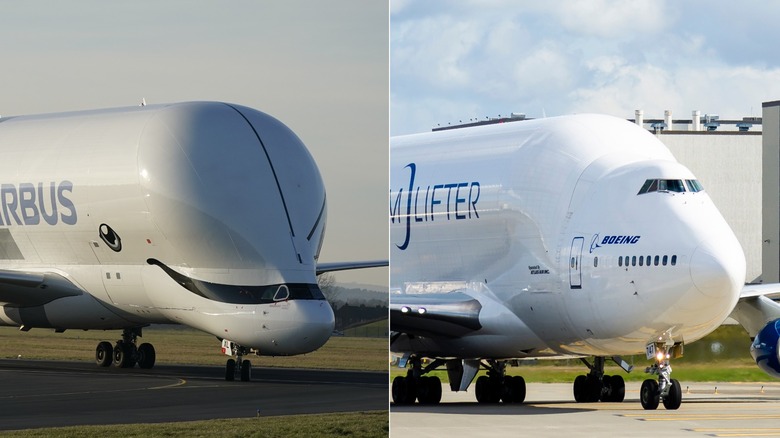
Richard Brew/Shutterstock & Christopher Furlong/Getty
Building an airliner is not a simple matter, with each aircraft consisting of countless parts. This complexity means that it’s nearly impossible to build these machines at just one location, with several companies across the globe involved in building them.
Advertisement
While most smaller parts are put in containers and pallets and are then shipped across to the final assembly sites of most jets, like the Boeing factories in North Charleston and Everett or the Airbus plants in Toulouse and Hamburg, some parts are just too big to fit in a 40-foot container. This means that huge parts like the wings of the Airbus A350 or parts of the Boeing 787 had to have special transport that could accommodate them.
It would be cheaper to transport these parts by sea, but that would be massive logistical headache, especially when factories are not located near a major port. Sailing a ship from one end of the globe to the other can take a lot of time, while flying a specially designed cargo plane would take just a day or two.
Advertisement
Because of this, both Boeing and Airbus decided to create special freighter aircraft, the Boeing LCF Dreamlifter and the Airbus Beluga XL, that could accommodate their cargo requirements to build some of the most expensive commercial passenger jets ever. So, let’s take a quick look at both outsize cargo aircraft and then compare both of them to see which one is larger.
What is the Boeing LCF Dreamlifter?
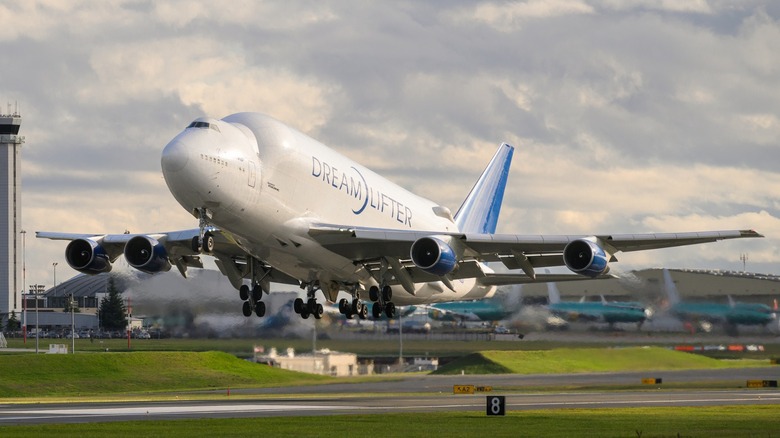
Ian Dewar Photography/Shutterstock
One of the first outsize cargo aircraft, the Aero Spacelines Pregnant Guppy, was built from a Boeing 377. However, since Boeing did not build the final aircraft, we cannot say that it was a «true» Boeing product. Instead, the first outsized cargo aircraft to come from Boeing is the Boeing LCF Dreamlifter, with LCF meaning Large Cargo Freighter. The plane received the «Dreamlifter» moniker because Boeing built it specifically to carry the parts of the then new Boeing 787 Dreamliner project from across the globe.
Advertisement
The Boeing LCF Dreamlifter is based on existing passenger versions of the Boeing 747-400 that some airlines have retired. Two of the 747s were sourced from Malaysia Airlines, while Air China (a Mainland China-based airline) and China Airlines (a Taiwan-based airline) each donated one airframe, totaling four Boeing LCF Dreamlifters.
Conversion of these 747-400s began in 2005 in Taiwan, with the first one taking to the air in 2006. By 2008, all four models are in the air, constantly shuttling across the globe and transferring parts for the Boeing 787 Dreamliner project.
What is the Airbus BelugaXL?
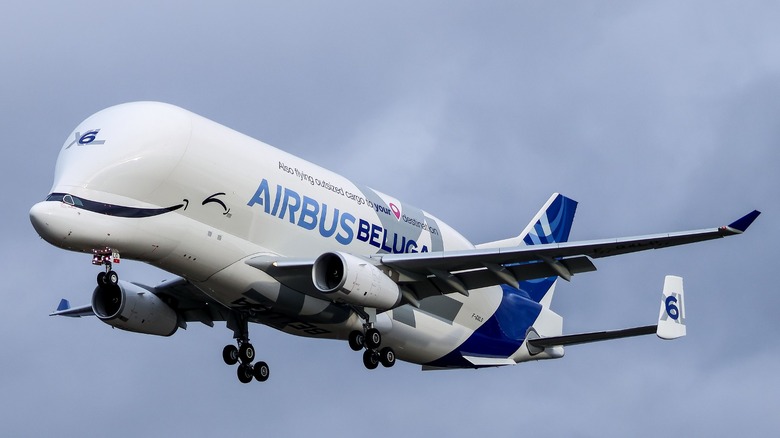
Antonio Pirro/Getty
Airbus is mainly a European venture built by many different European companies. Since its manufacturing plants are spread in a larger location early on, it really needed an outsized cargo freighter to move parts about. So, Airbus bought two outsized Super Guppy aircraft (the successor to the Pregnant Guppy) and built two more.
Advertisement
As these aircraft were getting older, Airbus decided to replace them with the BelugaST in the mid-1990s — an outsized transporter built on the base of an A300-600 twin-engine airplane. But with these airframes approaching 30 years old, Airbus decided to replace them with the Airbus BelugaXL. The BelugaXL is based on the A330-200F freighter, and Airbus operates six copies of this large freighter aircraft through its internal airline, Airbus Transport International.
The BelugaXL jets can carry 30% more weight than the previous BelugaST, allowing it to carry two A350 XWB wings (compared to the previous model which can only accommodate one). But despite that, it has a much longer flight range of 4,000 km — 2,350 km more than its predecessor. This is particularly useful as Airbus now has suppliers outside of Europe and are even assembling and making final Aircraft deliveries in both China and the U.S.
Advertisement
Which airplane is larger in size?
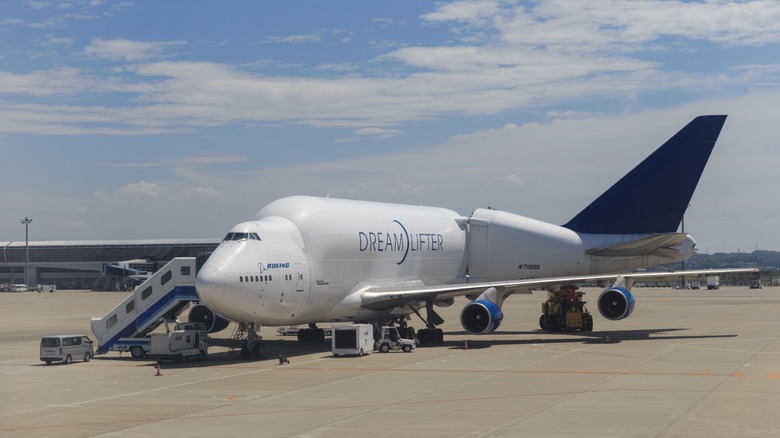
Winhorse/Getty
The Boeing LCF Dreamlifter is based off the Boeing 747-400, the Queen of the Skies, while the Airbus BelugaXL uses the smaller Airbus A330-200 Freighter as its starting point. Even though both manufacturers have added significant girth to the fuselages of the concerned aircraft models, we can still see the massive size of the larger donor.
Advertisement
The Airbus BelugaXL has a 60.3-meter wingspan, and its fuselage is 63.1 meters long. It also has height of 18.9 meters, while two Rolls-Royce Trent 700 engines — some of the most revolutionary engines ever made — push it into the air. Its cargo compartment opens up above the cockpit, kind of like a giant forehead that swallows huge aircraft parts. That’s why you’ll also notice that the nose of the BelugaXL is lowered a bit compared to the rest of the plane.
On the other hand, the Boeing LCF Dreamlifter has a wingspan of 64.4 meters and is 71.68 meters long. It also has a height of 21.54 meters, and it’s powered by four Pratt & Whitney PW4000 engines. And, unlike most cargo planes which open up front, the Boeing LCF Dreamlifter’s tail swings towards the right to make it easier to load and unload cargo.
Advertisement
Which cargo plane can carry more volume?
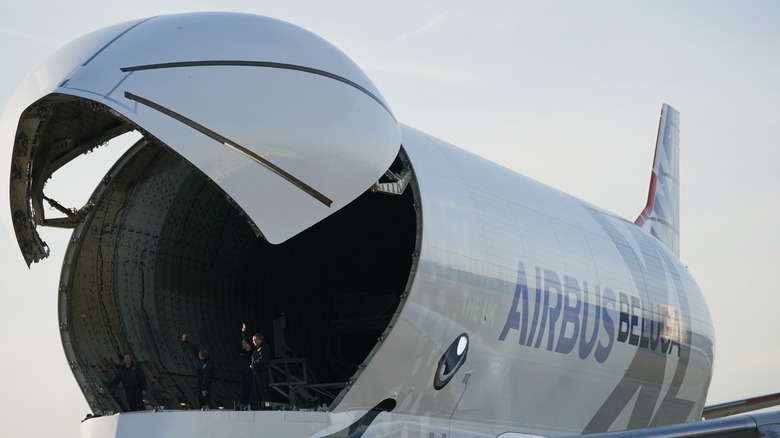
Christopher Furlong/Getty
But even if the Boeing LCF Dreamlifter is the bigger aircraft of the two, you’d be surprised to know that it’s doesn’t have a roomier interior. That’s because the Dreamliner «only» has 65,000 cubic feet of cargo space. This is about three times the cargo volume of a standard 747-400 freighter, but the Airbus BelugaXL has an even larger cargo bay.
Advertisement
The Airbus BelugaXL is a bit more spacious than the Dreamlifter by a magnitude of 13,000 cubic feet. This gives it a total cargo space of 78,000 cubic feet. To put this size into perspective, a single standard cement mixer has about 390 cubic feet of volume in the back, which means the BelugaXL’s cargo bay is about 200 times bigger than the cement trucks we encounter on the streets.
However, even though the BelugaXL can accommodate that much concrete, it doesn’t mean that it could take off with that weight. That’s because there’s a difference between the amount of cargo you can put into a plane and the weight that it can safely take into the sky. For that we will have to look at the maximum take-off weight of each aircraft and their payloads to see which one can carry the heavier cargo.
Advertisement
Which aircraft has the greater maximum take-off weight?
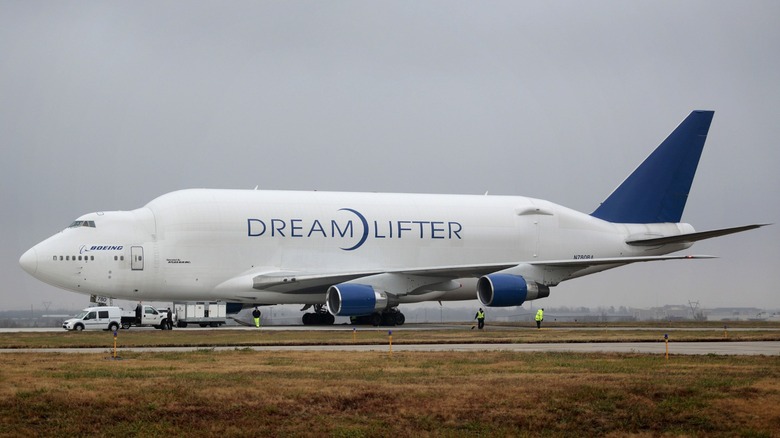
Brett Deering/Getty
Despite having greater volume, the Airbus BelugaXL’s smaller base shows in its MTOW (maximum take-off weight) and payloads. This twin-engine outsized freighter has an MTOW of 500,444 lbs., which includes its cargo, plus the weight of the plane itself, and the fuel needed to fly it. On the other hand, its maximum payload is just 111,332 lbs.
Advertisement
But if you look at the Boeing LCF Dreamlifter, which is based on the much heavier Boeing 747-400, you’ll see that it has an MTOW of 802,992 lbs. — more than 300,000 lbs. greater than the BelugaXL. It even has almost triple the maximum payload, which is 330,690 lbs. The Boeing’s four engines really come into play here, allowing it to carry heavier cargo. But does it really matter?
Although airplane parts are bulky and fragile, they often don’t tend to weigh much. Since these are airplane parts, most of the cargo that these freighter aircraft bring are often light and not very dense. So, even if the BelugaXL has a much smaller payload limit than the Dreamlifter, it’s still more than enough for Airbus’ needs. On the other hand, the Boeing LCF Dreamlifter’s larger capacity makes it useful for other tasks aside from flying airplane parts, like when it was tapped during the pandemic to help distribute the medical equipment and supplies needed across the globe.
Advertisement